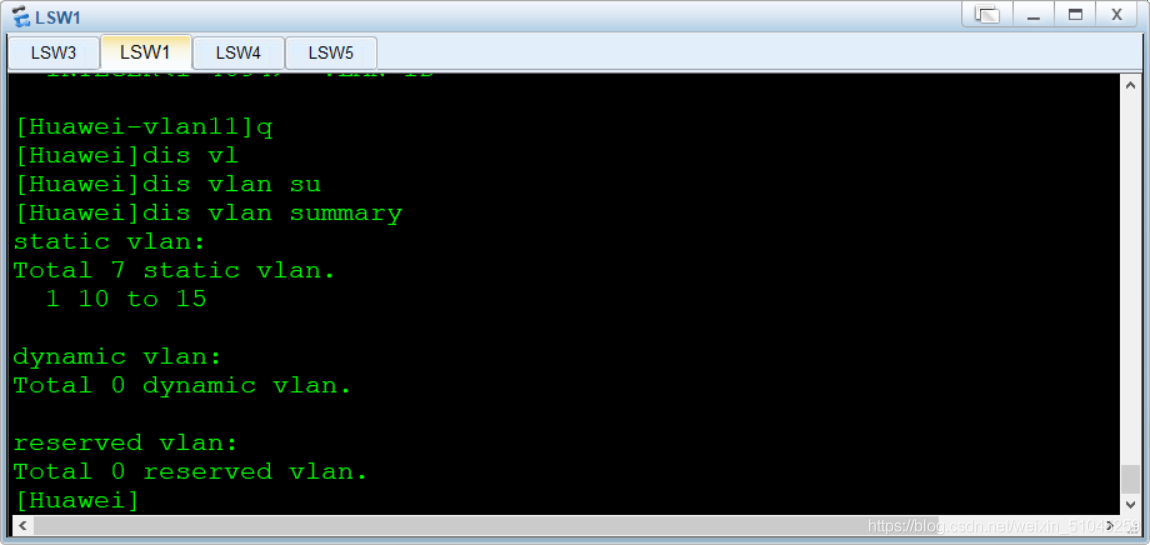Python實現網絡自動化eNSP
1.使用Paramiko登陸到單臺交換機
實驗拓撲
雲彩橋接到本機環回接口:192.168.1.1/24
三層交換機IP:192.168.1.2/24

實驗要求
使用Python Paramiko 模塊實現SSH 登錄單個交換機(192.168.56.2/24),配置LoopBack0地址:1.1.1.1/32。配置完成後,保存退出。
實驗步驟 配置交換機管理地址,並測試與主機虛擬網卡連通性
[Huawei]vlan 10 [Huawei]int vlan 10 [Huawei-Vlanif10]ip add 192.168.1.2 24 [Huawei-GigabitEthernet0/0/1]port link-type access [Huawei-GigabitEthernet0/0/1]port default vlan 10


配置三層交換機開啟 SSH 服務端,配置 SSH 賬號密碼。
[Huawei]user-interface vty 0 4 [Huawei-ui-vty0-4]authentication-mode aaa [Huawei-ui-vty0-4]protocol inbound ssh [Huawei-aaa]local-user python password cipher 123 [Huawei-aaa]local-user python privilege level 3 [Huawei-aaa]local-user python service-type ssh [Huawei]stelnet server enable [Huawei]ssh authentication-type default password
Python代碼
import paramiko
import time
ip = '192.168.56.2'
username = 'python'
password = '123'
ssh_client = paramiko.SSHClient()
ssh_client.set_missing_host_key_policy(paramiko.AutoAddPolicy()) //默認情況下,Paramiko會拒絕任何未知的SSH public keys,使用此函數使其接收來自交換機提供的public keys。
ssh_client.connect(hostname=ip, username=username, password=password, look_for_keys=False)
print('Successfully connect to ' + ip)
commend = ssh_client.invoke_shell()
commend.send('sys\n')
commend.send('interface LoopBack 0\n')
commend.send('ip add 1.1.1.1 255.255.255.255\n')
commend.send('return\n')
commend.send('save\n')
commend.send('y\n')
time.sleep(3) //稍等3秒,然後執行以下操作
output = commend.recv(65535) //截取本次運行script後的所有輸出記錄,將其assign給output變量
print(output.decode("ascii"))
ssh_client.close()
查看運行結果

在交換機上查看

也可以在交換機上debuggiing ip packet可以看到日志
2.使用Paramiko登陸到連續子網交換機
實驗拓撲
連續子網三層交換機:管理地址 192.168.1.2/24 to 192.168.1.5/24

實驗要求
登陸到各臺交換機,並為其配置vlan 11 to 15,保存配置並退出。
實驗步驟
配置管理口IP地址,並配置SSH Server 登陸名以及密碼等
python代碼
import paramiko
import time
#import getpass
#username = input('Username: ')
#password = getpass.getpass('Password: ') //pycharm中該模塊運行沒反應,用戶名和密碼還是直接寫的
username = 'python'
password = '123'
for i in range(2, 6):
ip = '192.168.1.' + str(i)
ssh_client = paramiko.SSHClient()
ssh_client.set_missing_host_key_policy(paramiko.AutoAddPolicy())
ssh_client.connect(hostname=ip, username=username, password=password, look_for_keys=False)
command = ssh_client.invoke_shell()
print('Successfully connect to ' + ip)
command.send('sys\n')
for j in range(11, 16):
print('正在創建VLAN: ' + str(j))
command.send('vlan ' + str(j) + '\n')
time.sleep(1)
command.send('return\n')
command.send('save\n')
command.send('y\n')
time.sleep(2)
output = command.recv(65535).decode('ascii')
print(output)
ssh_client.close()
運行結果


3.Paramiko登陸不連續子網交換機
實驗拓撲
將交換機LSW5的管理接口ip更改為192.168.1.6/24,使交換機ip不在同一網段

實驗要求
使用Paramiko登陸四臺ip不連續的交換機,並給其配置vlan11 to 15
實驗步驟
創建一個文本文檔,將需要配置的交換機的ip地址寫入,這裡我在Desktop下創建瞭一個名為ip.txt文檔

使用open函數,打開文件,進行操作,實現不連續子網調用
import paramiko
import time
username = 'python'
password = '123'
f = open('C:/Users/DELL/Desktop/ip.txt', 'r')
for line in f.readlines():
ip = line.strip()
ssh_client = paramiko.SSHClient()
ssh_client.set_missing_host_key_policy(paramiko.AutoAddPolicy())
ssh_client.connect(hostname=ip, username=username, password=password)
print('Successfully connect to ', ip)
command = ssh_client.invoke_shell()
command.send('sys\n')
command.send('vlan batch 11 to 15\n')
time.sleep(2)
command.send('return\n')
command.send('save\n')
command.send('y\n')
time.sleep(2)
output = command.recv(65535).decode('ascii')
print(output)
f.close()
ssh_client.close()
查看運行結果



4.sys.argv[ ] 實現靈活調用腳本所需文件
實驗拓撲
假設1.2和1.3為一組,1.4和1.6為一組

實驗要求
同時修改不同型號設備的配置,給SW1/3配置vlan11 to 15,SW4/5配置vlan16 to 20
實驗步驟
創建兩個名為ip1.txt,command1.txt的文件,存儲1組的ip和要進行的配置

同樣創建兩個名為ip2.txt,command2.txt文件,存儲2組的ip和要進行的配置


python代碼
import paramiko
import time
import sys
username = 'python'
password = '123'
ip_file = sys.argv[1]
cmd_file = sys.argv[2]
iplist = open(ip_file)
for line in iplist.readlines():
ip = line.strip()
ssh_client = paramiko.SSHClient()
ssh_client.set_missing_host_key_policy(paramiko.AutoAddPolicy())
ssh_client.connect(hostname=ip, username=username, password=password)
print('Successfully connect to ', ip)
command = ssh_client.invoke_shell()
cmdlist = open(cmd_file, 'r')
cmdlist.seek(0)
for line in cmdlist.readlines():
command.send(line + '\n')
time.sleep(5)
cmdlist.close()
output = command.recv(65535)
print(output)
iplist.close()
ssh_client.close()
查看運行結果(pycharm不可以使用argv,在cmd裡使用)

5.SSH連接失敗處理
import paramiko
import time
import sys
import socket
import getpass
username = input('Username: ')
password = getpass.getpass('Password: ')
ip_file = sys.argv[1]
cmd_file = sys.argv[2]
switch_with_authentication_issue = []
switch_not_reachable = []
iplist = open(ip_file, 'r')
for line in iplist.readlines():
try:
ip = line.strip()
ssh_client = paramiko.SSHClient()
ssh_client.set_missing_host_key_policy(paramiko.AutoAddPolicy())
ssh_client.connect(hostname=ip, username=username, password=password,look_for_keys=False)
print('Successfully connect to ' + ip)
command = ssh_client.invoke_shell()
cmdlist = open(cmd_file, 'r')
cmdlist.seek(0)
for cmd in cmdlist.readlines():
command.send(cmd + '\n')
time.sleep(1)
cmdlist.close()
output = command.recv(65535)
print(output.decode("ascii"))
except paramiko.ssh_exception.AuthenticationException:
print('User authentication failed for ' + ip + '.')
switch_with_authentication_issue.append(ip)
except TimeoutError:
switch_not_reachable.append(ip)
iplist.close()
ssh_client.close()
print('\nUser authentication failed for below switches: ')
for i in switch_with_authentication_issue:
print(i)
print('\nBelow switchs are not reachable: ')
for i in switch_not_reachable:
print(i)
到此這篇關於Python實現網絡自動化eNSP的實現的文章就介紹到這瞭,更多相關Python 網絡自動化 內容請搜索WalkonNet以前的文章或繼續瀏覽下面的相關文章希望大傢以後多多支持WalkonNet!
推薦閱讀:
- python 遠程執行命令的詳細代碼
- 使paramiko庫執行命令時在給定的時間強制退出功能的實現
- python 第三方庫paramiko的常用方式
- python基於paramiko庫遠程執行 SSH 命令,實現 sftp 下載文件
- 詳解python連接telnet和ssh的兩種方式